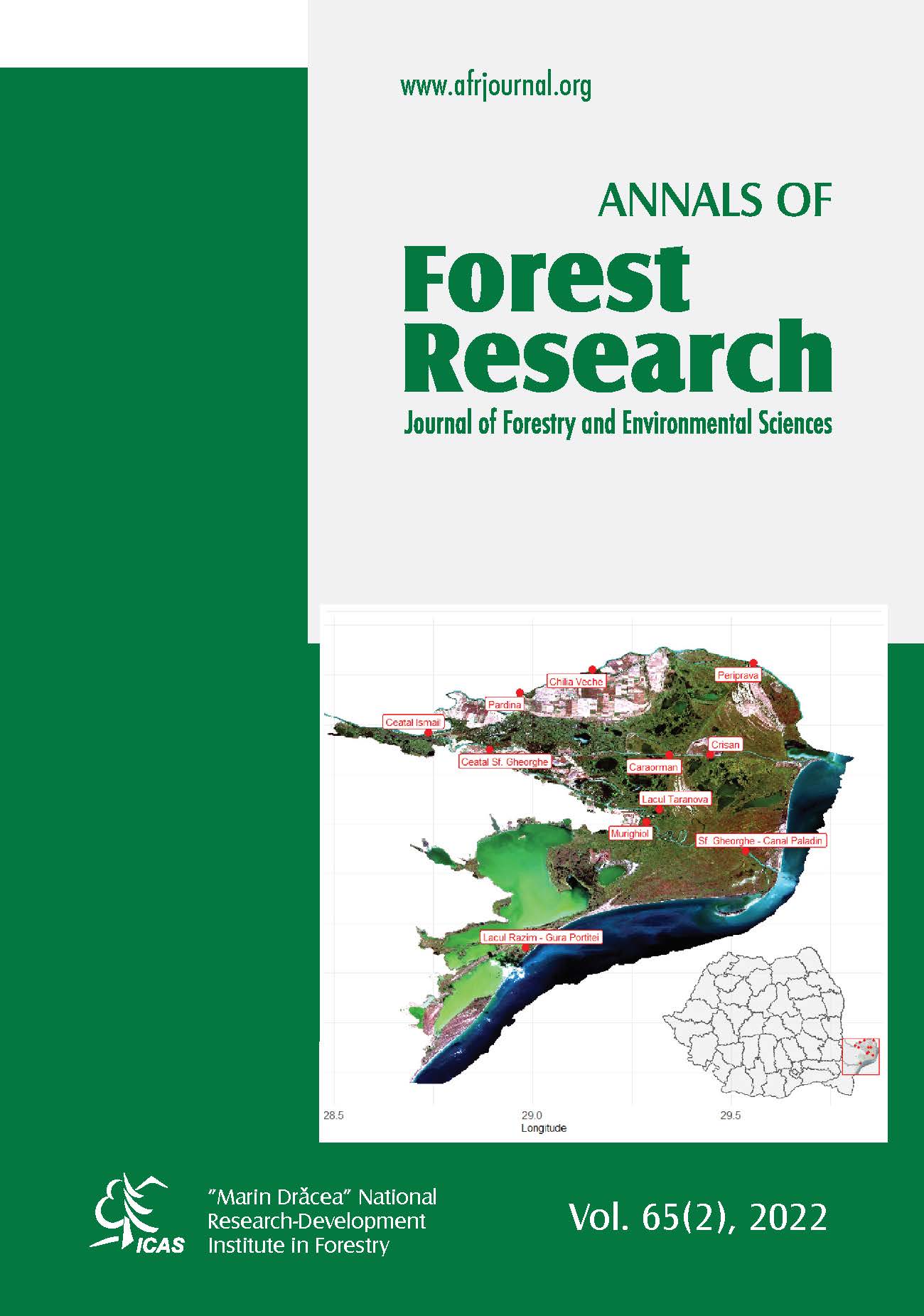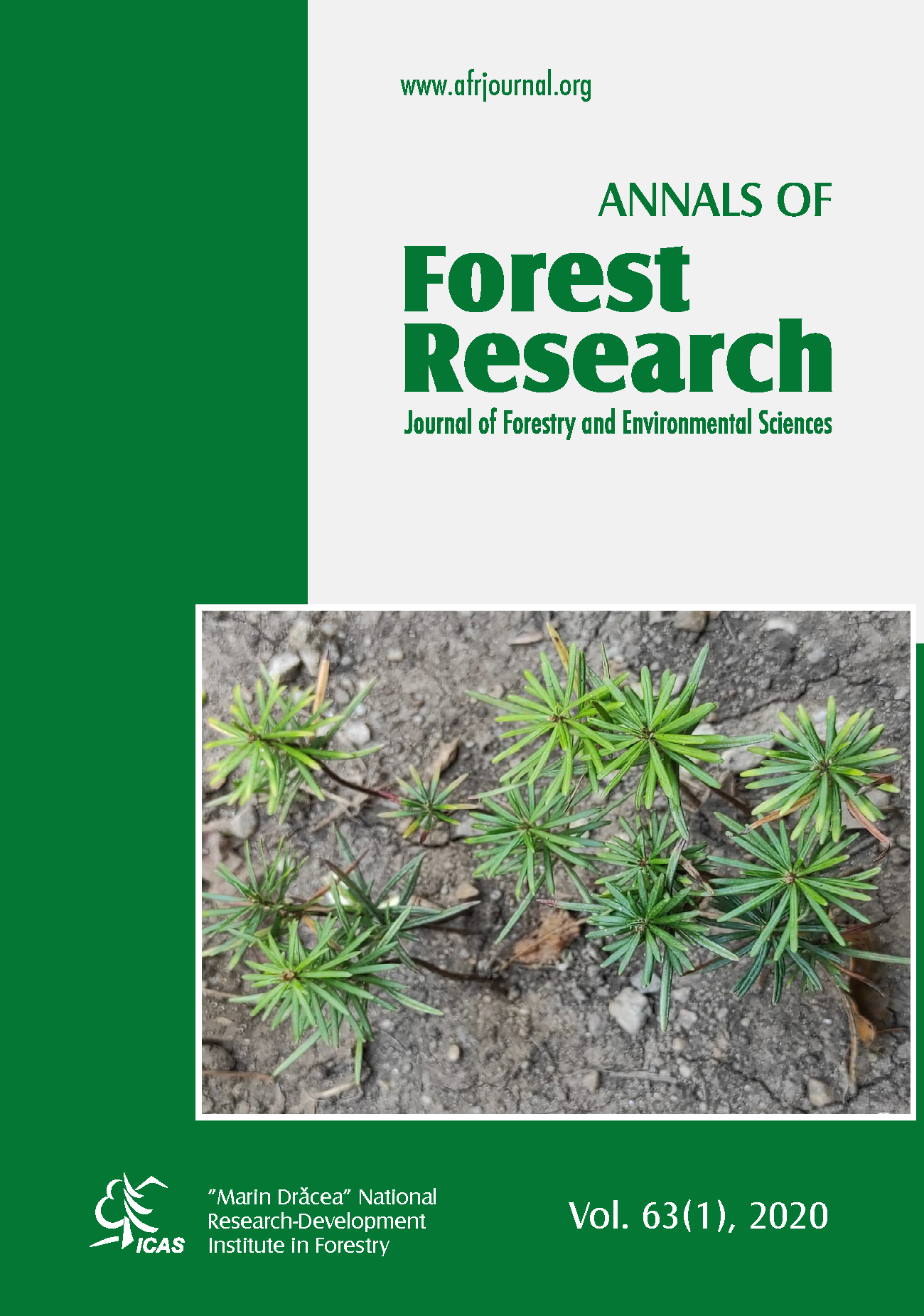Emissions of CO2 from downed logs of different species and the surrounding soil in temperate forest
DOI:
https://doi.org/10.15287/afr.2022.2386Keywords:
deadwood, decay rate, forest ecosystem, soil organic matter, temperate forestAbstract
The decomposition of deadwood plays a very important role in the functioning of the forest ecosystem. The present study was conducted with the objectives to: (1) determine the amount of deadwood respiration depending on species and degree of decomposition; (2) determine the extent of the impact of decomposing wood on the amount of respiration in surrounding soil; (3) find a relationship between the amount of respiration and the chemical fractional composition of soil organic matter. Our research has shown that respiration of decaying wood samples was 2-3 times lower compared to soil, regardless of the type of wood and the degree of wood decomposition. The conducted analyses confirmed the influence of the species of wood and the degree of decomposition on the respiration rate in wood samples. More decomposed wood (4th and 5th degree of decomposition) releases more CO2 compared to less decomposed wood and the highest CO2 emissions were recorded for aspen and alder wood. Better understanding of the mechanisms and factors affecting CO2 emissions in forest ecosystem can help reduce climate change.
References
Alef K., Nannipieri P., 1995. Enzyme activities. In: Nannipieri P, Alef K (eds). Methods in applied soil microbiology and biochemistry. London: Academic Press: 311–75.
Błońska E., Kacprzyk M., Spólnik A., 2017. Effect of deadwood of different tree species in various stages of decomposition on biochemical soil properties and carbon storage. Ecological Research 32: 193–203. https://doi.org/10.1007/s11284-016-1430-3
Chambers J.Q., Schimel J.P., 2001. Respiration from coarse wood litter in central Amazon forests. Biogeochemistry 52: 115–131. http://dx.doi.org/10.1023/A:1006473530673
Chapin F. S. III., Matson P. A., Vitousek P. M., 2011. Principles of Terrestrial Ecosystem Ecology. 2nd Edn. New York, NY: Springer. http://dx.doi.org/10.1007/978-1-4419-9504-9
Clausen C. A., 1996. Bacterial associations with decaying wood: A review. International Biodeterioration and Biodegradation 37: 101– 107. http://dx.doi.org/10.1016/0964-8305(95)00109-3
Cocciufa C., Gerth W., Luiselli L., Redolfi de Zan L., Cerretti P., Carpaneto GM., 2014. Survey of saproxylic beetle assemblages at different forest plots in central Italy. B. Bulletin of Insectology 67: 295–306.
Dziadowiec H., Gonet S., 1999. Przewodnik metodyczny do badań materii organicznej gleb. Prace Komisji Naukowych PTG 20: 42–43.
Feng W., Liang J., Hale L.E., Jung C.G., Chen J., Zhou J., Xu M., Yuan M., Wu L., Braccho R., Pegoraro E., Schuur E.A., Luo Y., 2017. Enhanced decomposition of stable soil organic carbon and microbial catabolic potentials by long-term field warming. Global Change Biology 23: 4765– 4776. http://dx.doi.org/10.1111/gcb.13755
Harmon M.E., Franklin J.F., Swanson F.J., et al., 1986. Ecology of coarse woody debris in temperate ecosystems. Advances in ecological research 15: 133–302. http://dx.doi.org/10.1016/S0065-2504(03)34002-4
Herrmann S., Bauhus J., 2013. Effects of moisture, temperature and decomposition stage on respirational carbon loss from coarse woody debris (CWD) of important European tree species. Scandinavian Journal of Forest Research 28:4: 346-357. http://dx.doi.org/10.1080/02827581.2012.747622
Hopkins D. W., 2008. Carbon mineralization. In Soil Sampling and Methods of Analysis (eds. Carter M. R. & Gregorich E. G.) (CRC Press,)
Kahl T., Arnstadt, T., Baber K., et al., 2017. Wood decay rates of 13 temperate tree species in relation to wood properties, enzyme activities and organismic diversities. Forest Ecology and Management 391: 86–95. http://dx.doi.org/10.1016/j.foreco.2017.02.012
Kögel-Knabner I., 2002. The macromolecular organic composition of plant and microbial residues as inputs to soil organic matter. Soil biology and biochemistry 34: 139–62. http://dx.doi.org/10.1016/j.soilbio.2016.08.011
Kupka D., Kania, M., Gruba P., 2021. The proximity of a highway increases CO2 respiration in forest soil and decreases the stability of soil organic matter. Scientific Reports 11: 21605. https://www.nature.com/articles/s41598-021-00971-7
Lasota J., Błońska E., Piaszczyk W., Wiecheć M., 2018. How the deadwood of different tree species in various stages of decomposition affected nutrient dynamics? Journal of Soils and Sediments 18: 2759–2769. https://link.springer.com/article/10.1007/s11368-017-1858-2
Mäkipää R., Rajala T., Schigel D. et al., 2017. Interactions between soil- and dead wood-inhabiting fungal communities during the decay of Norway spruce logs. The ISME journal 11(9): 1964-1974. http://dx.doi.org/10.1038/ismej.2017.57
Maser C, Anderson RG, Cromak K et al., 1979. Dead and down woody material. In: Wildlife habitats in managed forests: the blue mountains of Oregon and Washington. Thomas JW (eds) USDA Forest Service Agricultural Handbook; 553: 78 – 95.
Olajuyigbe S., Tobin B., Nieuwenhuis M., 2012. Temperature and moisture effects on respiration rate of decomposing logs in a Sitka spruce plantation in Ireland. Forestry 85: 485– 496. http://dx.doi.org/10.1093/forestry/CPS045Ottosson E,. Nordén J,. Dahlberg A,. Edman M,. Jönsson M,. Larsson K-H., et al., 2014. Species associations during the succession of wood-inhabiting fungal communities. Fungal Ecology 11: 17–28. http://dx.doi.org/10.1016/j.funeco.2014.03.003Pan Y,. Birdsey R.A., Fang J., Houghton R., Kauppi P.E., Kurz W.A., Phillips O.L., Shvidenko A., Lewis S.L., Candell J.G., Ciais P., Jackson R.B., Pacala S.W., McGuire A.P., Piao S., Rautiainen A., Sitch S., Hayes D., 2011. A large and persistent carbon sink in the world's forests. Science 333: 988–993. http://dx.doi.org/10.1126/science.1201609Piaszczyk W, Błońska E, Lasota J, Lukac M., 2019a. A comparison of C:N:P stoichiometry in soil and deadwood at an advanced decomposition stage. Catena 179: 1-5. http://dx.doi.org/10.1016/j.catena.2019.03.025
Piaszczyk W., Błońska E., Lasota J., 2019b. Soil biochemical properties and stabilisation of soil organic matter in relation to deadwood of different species. FEMS Microbiology Ecology 95 (3), fiz011. http://dx.doi.org/10.1093/femsec/fiz011
Piaszczyk W., Lasota J., Błońska E., Foremnik K., 2022. How habitat moisture condition affects the decomposition of fine woody debris from different species. Catena 208: 105765. http://dx.doi.org/10.1016/j.catena.2021.105765
Pichler V., Homolák M., Skierucha W., Pichlerová M., Ramírez D., Gregor J., Jaloviar P., 2011. Variability of moisture in coarse woody debris from several ecologically important tree species of the Temperate Zone of Europe. Ecohydrology 5: 424–434. http://dx.doi.org/10.1002/eco.235
Pietsch K.A., Eichenberg D., Nadrowski K., Bauhus J., Buscot F., Purahong W., Wipfler B., Wubet T., Yu M., Wirth C., 2018. Wood decomposition is more strongly controlled by temperature than by tree species and decomposer diversity in highly species rich subtropical forests. Oikos 128: 701-715. http://dx.doi.org/10.1111/oik.04879
Ravn N.R., Michelsen A., Reboleira A.S., 2020. Decomposition of Organic Matter in Caves. Frontiers in Ecology and Evolution 8: 554651. http://dx.doi.org/10.3389/fevo.2020.554651Rinne-Garmston K.T., Peltoniemi K., Chen J., Peltoniemi M., Fritze H., Mäkipää R., 2019. Carbon flux from decomposing wood and its dependency on temperature, wood N2 fixation rate, moisture and fungal composition in a Norway spruce forest. Global Change Biology 25: 1852-1867. http://dx.doi.org/10.1111/gcb.14594Russell M.B., Fraver S., Aakala T., Gove J.H., Woodall C.W., D'Amato A.W., Ducey M.J., 2015. Quantifying carbon stores and decomposition in deadwood: A review. Forest Ecology and Management 350: 107-128. http://dx.doi.org/10.1016/j.foreco.2015.04.033
Rawlik K., Nowiński M., Jagodziński A. M., 2021. Short life–fast death: decomposition rates of woody plants leaf-and herb-litter. Annals of Forest Science 78(1): 1-30. http://dx.doi.org/10.1007/s13595-020-01019-y
Robertson G.P., Paul E.A., 2000. Decomposition and Soil Organic Matter Dynamics. In: Sala O.E., Jackson R.B., Mooney H.A., Howarth R.W. (eds) Methods in Ecosystem Science. Springer, New York, NY. http://dx.doi.org/10.1007/978-1-4612-1224-9_8
Seibold S., Gossner M. M., Simons N. K., Blüthgen N., Müller J., Ambarlı D., ... & Weisser, W. W., 2019. Arthropod decline in grasslands and forests is associated with landscape-level drivers. Nature 574 (7780): 671-674. https://www.nature.com/articles/s41586-019-1684-3
Tuomi M., Laiho R., Repo A., Liski J., 2011. Wood decomposition model for boreal forests. Ecological Modelling 222: 709– 718. http://dx.doi.org/10.1016/j.ecolmodel.2010.10.025
Valentin L., Rajala T., Peltoniemi M., Heinonsalo J., Pennanen T., Makipaa R., 2014. Loss of diversity in wood-inhabiting fungal communities affects decomposition activity in Norway spruce wood. Frontiers in Microbiology, 230. http://dx.doi.org/10.3389/fmicb.2014.00230
Xu X., Schimel J.P., Thornton P.E., Song X., Yuan F., Goswami S., 2014. Substrate and environmental controls on microbial assimilation of soil organic carbon: a framework for Earth system models. Ecology Letters 17: 547– 555. http://dx.doi.org/10.1111/ele.12254
Zalamea M., González G., Lodge D.J., 2016. Physical, Chemical, and Biological Properties of Soil under Decaying Wood in a Tropical Wet Forest in Puerto Rico. Forests, 7(8), 168. http://dx.doi.org/10.3390/f708Downloads
Published
Issue
Section
License
All the papers published in Annals of Forest Research are available under an open access policy (Gratis Gold Open Access Licence), which guaranty the free (of taxes) and unlimited access, for anyone, to entire content of the all published articles. The users are free to "read, copy, distribute, print, search or refers to the full text of these articles", as long they mention the source.
The other materials (texts, images, graphical elements presented on the Website) are protected by copyright.
The journal exerts a permanent quality check, based on an established protocol for publishing the manuscripts. The potential article to be published are evaluated (peer-review) by members of the Editorial Board or other collaborators with competences on the paper topics. The publishing of manuscript is free of charge, all the costs being supported by Forest Research and Management Institute.
More details about Open Access:
Wikipedia: http://en.wikipedia.org/wiki/Open_access






